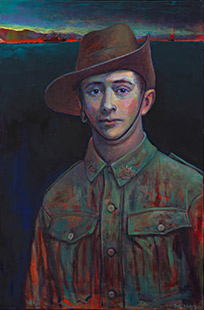 Soldiers bathing in Anzac Cove, a powerful portrait of 14-year-old Private James Martin in his ill-fitting Anzac uniform and a woman receiving devastating news via telegram – are just some of the images depicted in artworks by the thirty-five finalists selected for the 2020 Gallipoli Art Prize.
Soldiers bathing in Anzac Cove, a powerful portrait of 14-year-old Private James Martin in his ill-fitting Anzac uniform and a woman receiving devastating news via telegram – are just some of the images depicted in artworks by the thirty-five finalists selected for the 2020 Gallipoli Art Prize.
Due to Covid-19 restrictions, the 2020 Gallipoli Art Prize will not be hung in a public exhibition as has been done for the last fifteen years of Prize, rather people are invited to experience the works online via www.gallipoli.com.au after 16 April. It is hoped that a physical exhibition can be held later in the year.
“At a time when we are suffering great fear and loss worldwide, the Gallipoli Art Prize provides an important opportunity to reflect on periods of hardship in our collective history, including the 1919 influenza pandemic, and to commemorate those qualities that helped us through adversity,” said John Robertson, President of the Club and one of the judges of the prize.
The privately funded prize, auspiced by the Gallipoli Memorial Club in Sydney, invites artists to respond openly to the broad themes of loyalty, respect, love of country, courage and comradeship as expressed in the Gallipoli Club’s creed.
We believe that within the community there exists an obligation for all to preserve the special qualities of loyalty, respect, love of country, courage and comradeship which were personified by the heroes of the Gallipoli Campaign and bequeathed to all humanity as a foundation for perpetual peace and universal freedom.
The works in the Gallipoli Art Prize often tell personal and emotional stories. Each artist responds differently to the Gallipoli Club’s creed, making it a unique and diverse collection. The artworks are accompanied by artist statements providing poignant insight into their work.
Some of the finalists works relate directly to the experiences of family members who have served in the armed forces. Elizabeth McCarthy’s painting of Anzac Cove, With Fixed Bayonets They Went Straight Up the Hill Singing Tipperary, is inspired by entries in her grandfather’s Gallipoli diary. Bettina Fauvel-Ogden’s work, In Memory of my Grandfather, paints a portrait of her grandfather from an old wedding photo, re-imagined in a field of poppies.
The experience of women during wartime also features in this year’s works. Lori Pensini’s powerful work, The Telegram is a tribute to the rural women like her grandmother, who Pensini says in her accompanying statement “fought the loneliness of war and the ever lingering threat of an uncertain future on the land without their loved ones.”
Fleur Stevenson’s Heartland references the camouflage nets made by her grandmother to help protect her family fighting a war on the other side of the world from her New Zealand home.
Other finalists reference more recent events. In the statement accompanying her work, Breathe – depicting a series of gas masks, artist Alison Mackay talks of her personal experience of the recent bushfires, the mask she needed to wear for protection and the heroism of the Rural Fire Service.
In the statement accompanying his work, Silences, artist David Mackay talks of the current battle against a silent enemy Coronavirus and how “Now more than ever, we are being asked to call on the prevailing qualities of the soldiers who fought in the Gallipoli campaign – ‘courage, comradeship, and respect’ as we fight this silent enemy to preserve the human race.”
Previous winners of the Gallipoli Art Prize include renowned artists Euan Macleod (2009), Idris Murphy (2014) and Jiawei Shen (2016). Melbourne printmaker Martin King won the Gallipoli Art Prize in 2019 with a mixed media work, War Pigeon Diaries, consisting of seven open notebooks containing intricate prints of carrier pigeons that were used during WWI and WWII to carry vital messages behind enemy lines and for aerial surveillance.
The winner of the $20 000 Gallipoli Art Prize will be announced on Thursday 16 April 2020. For more information, visit: www.gallipoli.com.au for details.
Image: Sue Macleod-Beere, Private James Martin, 14 years old – courtesy of the artist and the Gallipoli Memorial Club
The 2020 Gallipoli Art Prize Finalists are:
Alison Mackay – Breathe
Andrew Tomkins – Slaters Knoll, The Morning After the Night Before
Belle Raine – Vapor
Betina Fauvel-Ogden – In Memory of My Grandfather
David McKay – Silences
Deidre Bean – Major Smith’s Petrichor
Elise Judd – The History Lesson
Elizabeth McCarthy – With Fixed Bayonets they went Straight up the Hill singing Tipperary
Emma Rebecca Liu – Thus Soldiers Jobs were Carried on
Errol Barnes – The Field
Fleur Stevenson – Heartland
Geoff Harvey – Gallipoli Narrative
Jessica Guthrie – Arlo’s Bugle
Julianne Allcorn – Hidden Beauty
Kristin Hardiman – Postcards of War
Leigh Hooker – The Crucible
Lori Pensini – The Telegram
Margaret Hadfield – Weary
Mark Emerson – Lost Digger of Vignacourt
Mark Middleton – A Calm Moment
Maryanne Wick – Under a Blood Orange Sky
Michael John Lodge – Geese on the Somme WW1
Michael Miller – Here they Come Lads
Nick Howson – December 17 Shell Green
Nicola Wilson – Ode to Olly
Paul Gorjan – Flying Officer
Peter Smeeth – First Australian P.O.Ws
Philip Meatchem – Ivor Hele, War Artist
Raj Panda – Lest We Forget
Rodney Pople – Hopes and Dreams
Ross Townsend – Spirits of Hellfire Pass
Sally West – Troops Swimming at Anzac Cove
Sam Dabboussy – Prelude 1915
Shonah Trescott – Ode to Private Furguson
Sue Macleod-Beere – Private James Martin, 14 years old
